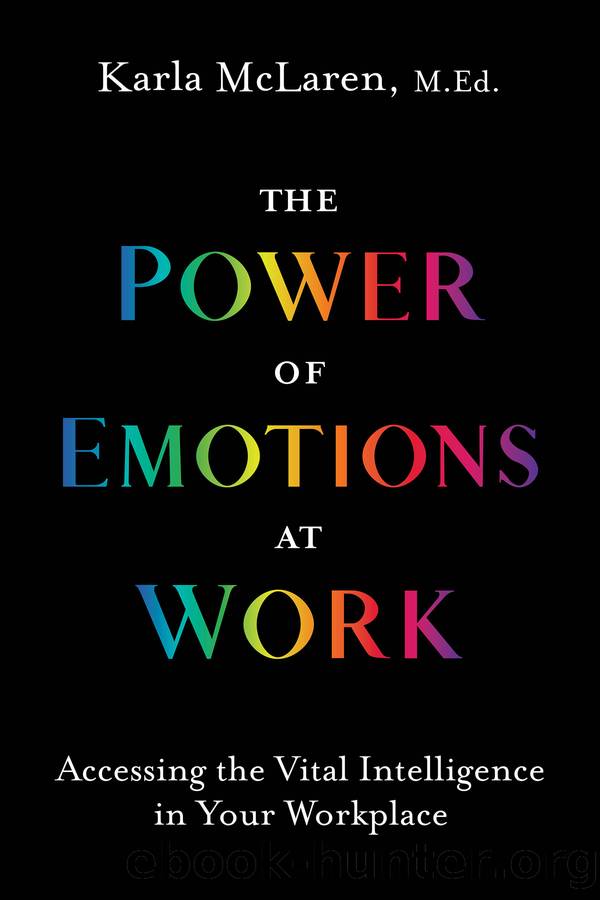The Power of Emotions at Work by Karla McLaren

Author:Karla McLaren
Language: eng
Format: epub
Publisher: Sounds True
Published: 2021-06-18T00:00:00+00:00
PART 2
Building Your Unique Healthy Workplace
5
Creating Communication Workflows for Everyday Emotional Issues
I have yet to find a workplace â in more than 40 years of searching â where there are defined and accessible processes to help workers deal with everyday social difficulties. Iâm not talking about big problems such as workplace injuries, workplace bullying, or sexual harassment â there are formal HR processes for those situations, plus labor laws, labor commissions, and each countryâs version of OSHA. What Iâm talking about are very simple communication difficulties that may occur several times each day.
I always ask, âDo your workers have a process for requesting attention from a busy person or asking someone to take over a task for them?â And I am met with blank stares. âWhat about asking a sensitive question without offending someone? Asking for help? Admitting that they made a mistake?â More blank stares. Crickets even.
When workers arenât provided with reliable ways to communicate about everyday interpersonal situations, they must cobble together methods from their private lives, from their schoolyard training, from previous jobs, or from thin air. This is an absurd waste of everyoneâs time, and it impedes workplace efficiency and emotional regulation from the word go. When workers donât even know how to ask each other questions or communicate their concerns, theyâll trip over each other and create mini conflicts throughout each day â usually without meaning to. Theyâll also have to ramp up their unpaid empathy work and become Peacemakers just to navigate through unspoken issues, unmet needs, mistaken assumptions, and difficult relationships â and they wonât be able to speak openly about any of it. Belonging and relatedness will suffer, multiple repair stations and gossip networks will have to arise just to keep everything (sort of) functional, and the workplace will be uncomfortable, inefficient, and wildly more likely to create the conditions that lead to employee silence about serious workplace problems.
When people donât have the tools they need to deal with simple, everyday communication issues, they wonât develop a sense of interpersonal competence, and theyâll often be too preoccupied or drained to deal with larger issues. Poor or nonexistent communication processes leave people unsupported and create unnecessary conflict throughout the workplace. This is an unsafe situation for everyone, but luckily, the solution is simple: Help workers develop effective skills for everyday difficulties, and theyâll have the energy, support, competence, sense of belonging, and skills they need to communicate effectively when critical problems occur. Weâll explore those skills in this chapter.
Another requirement in any communal environment is that people need to have access to privacy, relatedness, and comfort â physically as well as emotionally. These spaces help us rest and regulate ourselves so that we can work more effectively, but sadly, this is yet another place where the workplace fails us and creates unnecessary and unprofitable conflict and discomfort.
Healthy and emotionally well-regulated organizations should provide dedicated, welcoming, and communally agreed upon break areas; ways to find quiet and privacy; methods to share crucial emotional and
Download
This site does not store any files on its server. We only index and link to content provided by other sites. Please contact the content providers to delete copyright contents if any and email us, we'll remove relevant links or contents immediately.
Zero to IPO: Over $1 Trillion of Actionable Advice from the World's Most Successful Entrepreneurs by Frederic Kerrest(4405)
Machine Learning at Scale with H2O by Gregory Keys | David Whiting(4259)
Never by Ken Follett(3884)
Harry Potter and the Goblet Of Fire by J.K. Rowling(3808)
Ogilvy on Advertising by David Ogilvy(3554)
Shadow of Night by Deborah Harkness(3326)
The Man Who Died Twice by Richard Osman(3040)
Book of Life by Deborah Harkness(2893)
Will by Will Smith(2872)
The Tipping Point by Malcolm Gladwell(2870)
0041152001443424520 .pdf by Unknown(2815)
My Brilliant Friend by Elena Ferrante(2793)
How Proust Can Change Your Life by Alain De Botton(2771)
Purple Hibiscus by Chimamanda Ngozi Adichie(2739)
How to Pay Zero Taxes, 2018 by Jeff A. Schnepper(2621)
Hooked: A Dark, Contemporary Romance (Never After Series) by Emily McIntire(2527)
Rationality by Steven Pinker(2327)
Borders by unknow(2280)
Can't Hurt Me: Master Your Mind and Defy the Odds - Clean Edition by David Goggins(2277)
